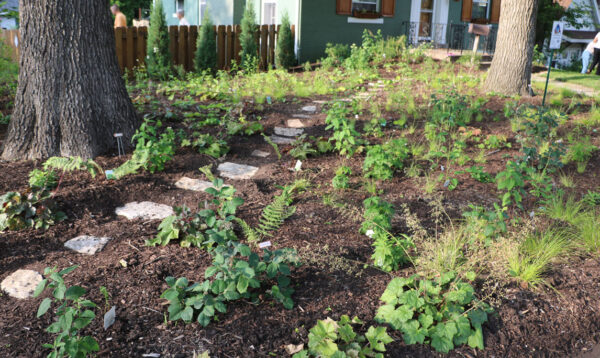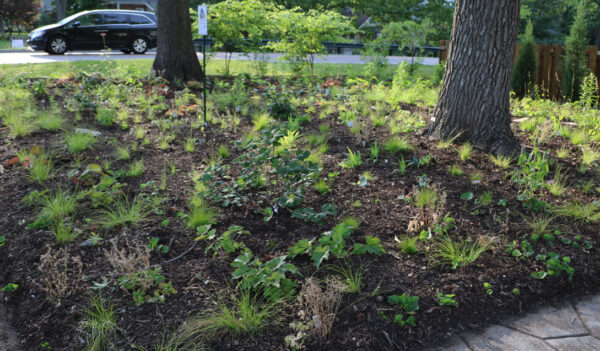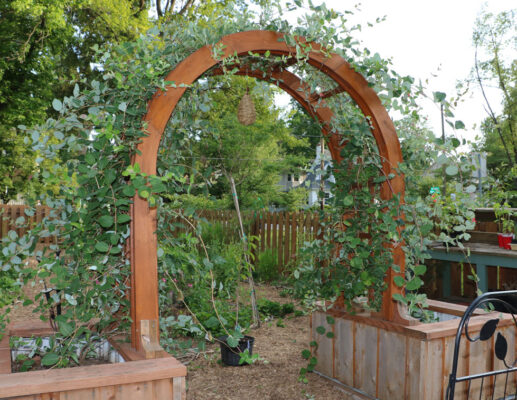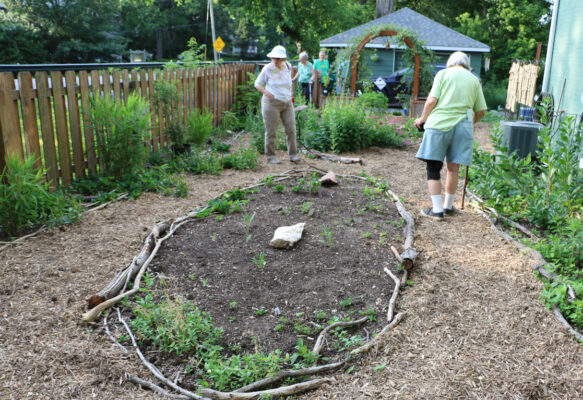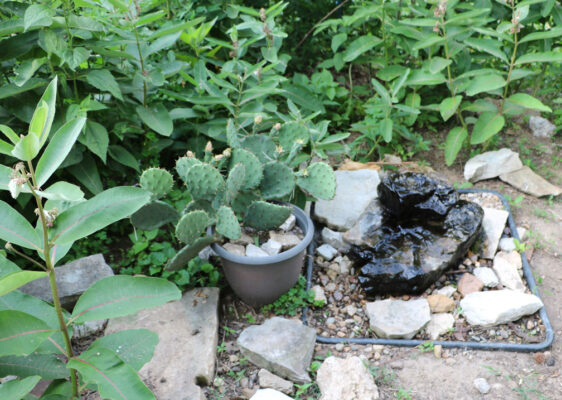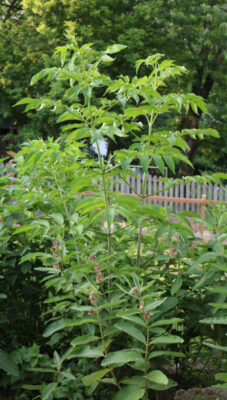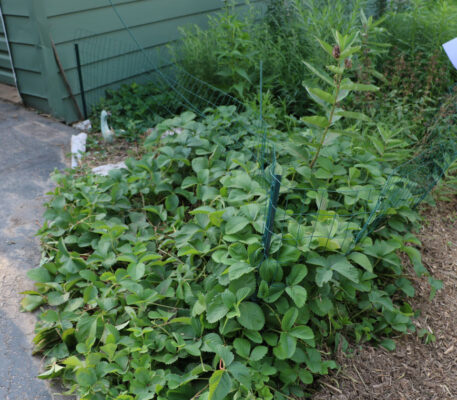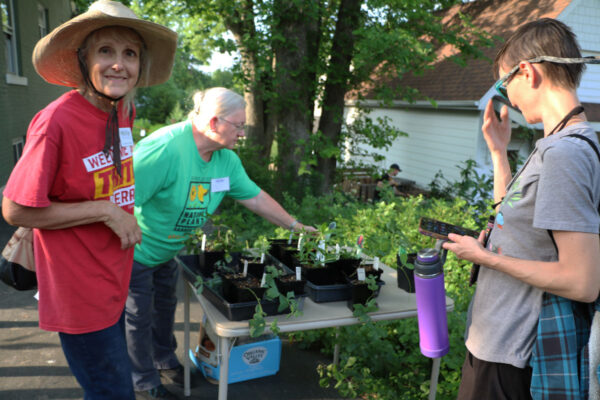post and photos by Donna Short, Chapter member and volunteer
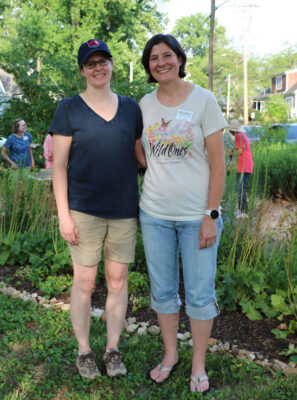 Home of Amy Maddin and Molly Dilley
Home of Amy Maddin and Molly Dilley
Wednesday Jun 14 (77 attendees)
Saturday Jun 17 (48 attendees)
Amy and Molly, thank you for sharing your garden and your story with us!
When they moved into their home in Webster Groves in 2011, they found a yard dominated by invasive plants. Later, they learned about the danger these plants pose to the native plants and trees. After reading Bringing Nature Home by Douglas Tallamy, they were further convinced but knew they were facing a major task. In 2018, they went to work! The invasives included the usual culprits: honeysuckle, winter creeper, clematis and bindweed.
Amy learned about native plants as a child when her mother introduced her to the ephemerals and woodland vegetation. Her mother encouraged her to contact Bring Conservation Home for an assessment and recommendations. There she learned of the Wild Ones Landscape Challenge. Her parents live in Columbia, IL and are members of the Wild Ones St Louis Chapter.
Two years ago, Amy and Molly were the winners of the Wild Ones Landscape Challenge (shown below). The major goal of the Landscape Challenge is to educate neighbors and community members on the importance of native plants to the environment. One of the reasons Amy and Molly received the grant is because their front yard is on a busy street at an intersection where the native plant message would have an audience. They continually hear positive feedback from people passing by their yard. Frequently, people pull over and chat or even yell “looks nice” or “you’re doing a great job” as they drive by. Amy is working to label all the plants to provide this informational layer for those passing by.
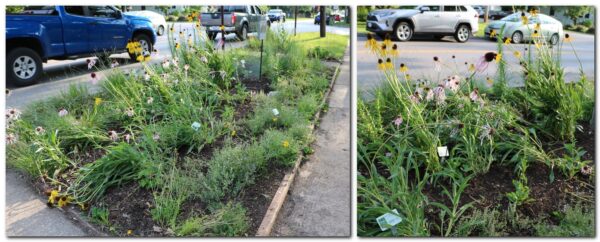
The plants here, along the street, are primarily sun-oriented. Pale Purple Coneflower (Echinacea pallida), Yellow Coneflower (Ratiba pinnata) and Calamint (Clinopodium arkansanum) are in bloom.

The planting, on the left, was also established during the Landscape Challenge. It includes a variety of plants such as Jacob’s Ladder (Polemonium reptans), on the right.
Last year Amy and Molly received a grant from the Deer Creek Watershed Alliance Rainscaping Program. The purpose of the grant was to replace turf grass with natives in the front yard. These plants are in an area shaded by a Shingle Oak (Quercus imbricaria) and a Sweetgum (Liquidambar styraciflua). See below. You’ll notice the difference in plant maturity between this area and the Landscape Challenge plants which are a year older. Included are: Littleflower Alumroot( Heuchera parviflora), Oak Sedge (Carex albicans), Marginal Wood Fern (Dryopteris marginalis), Spikenard (Aralia racemosa) and more.
Around the side of the house is a garden that was previously a woodland, shaded by ten full size Tree of Heaven (Ailanthus altissima). These trees are an aggressive invasive species and were removed. Elimination of the trees created a new challenge since the garden now receives full western sun and some of the plants will not be able to tolerate this environment.
The long view of the woodland garden – some plants haven’t survived the change to full sun (left). Now this garden is a work in progress as they find plants compatible with the sun exposure.
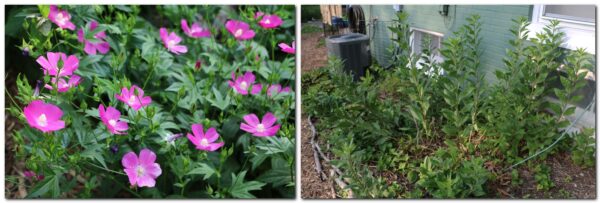
Bush’s Poppy Mallow (Callirhoe bushii) shown left and Showy Goldenrod (Solidago speciosa) below. Both are thriving!
Other plants included here are Wild Strawberry (Fragaria virginiana), Butterfly Milkweed (Asclepias tuberosa), Blue Lobelia (Lobelia siphilitica) and Marsh Milkweed (Asclepias incarnata).
Moving to the rear yard, there is a bubbler and a pot of Prickly Pear (Opuntia humifusa).
According to Amy, this hill was originally covered with invasive honeysuckle. She planted five or size Common Milkweed (Asclepias syriaca) at the bottom of the hill and they multiplied to eight. In 2020, Amy and Molly removed the honeysuckle and the milkweed took over the entire hill. In 2021 they added other plants to provide some variety and the milkweed retreated to the edges. Evidently it prefers not to compete with the other plants!
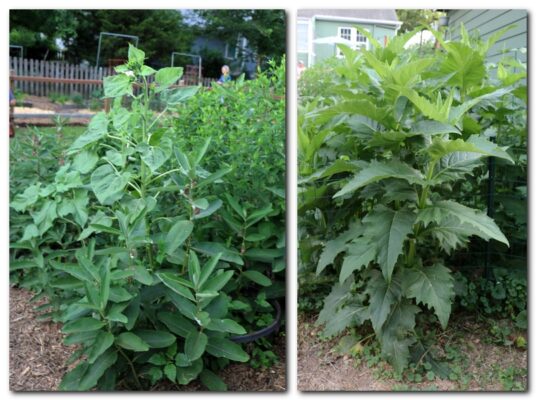
Common Sunflower (Helianthus annuus) shown left, suddenly appeared on the scene. Cup Plant (Silphium perfoliatum) shown right.
Other plants in this area include BeeBalm (Monarda bradburiana), Joe Pye Weed (Eutrochium purpureum), Wild Quinine (Parthenium integrifolium), Switch Grass (Panicum virgatum), Indian Grass (Sorghastrum nutans) and more.
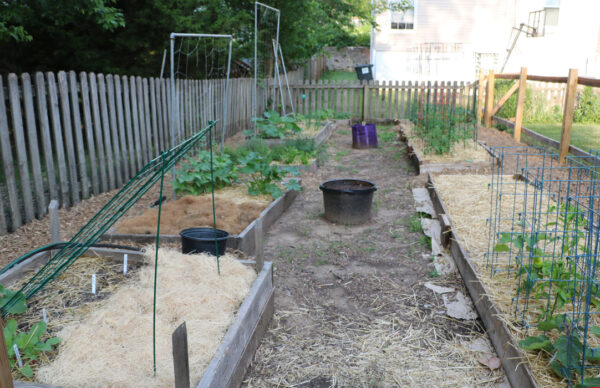
The vegetable garden in the rear of the yard includes tomatoes, pepper, eggplant, squash, and beans. Nearby are chickens.
Congratulations to Amy and Molly on their Bring Conservation Home platinum certification which was awarded to them shortly before the Gathering! For additional information on the requirements for this certification see the BCH website.
All Garden Gatherings feature free plants which are brought by members to share. Wild Ones members select from plants brought to the Wednesday Gathering (right).

